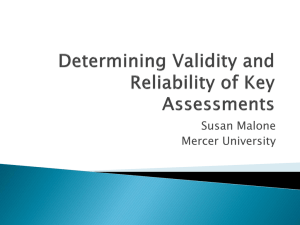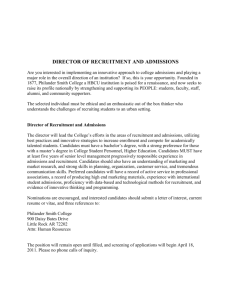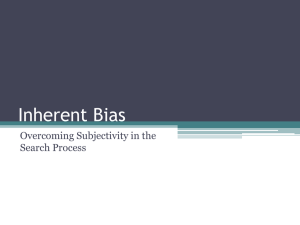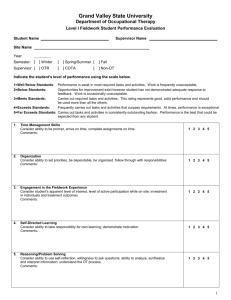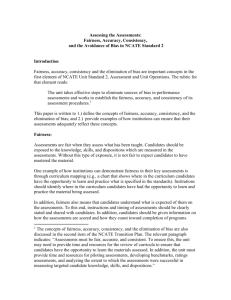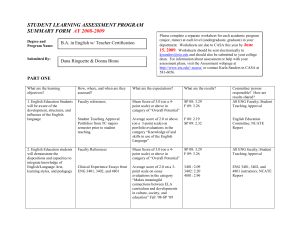2A.5. Procedures to Ensure Fairness
advertisement
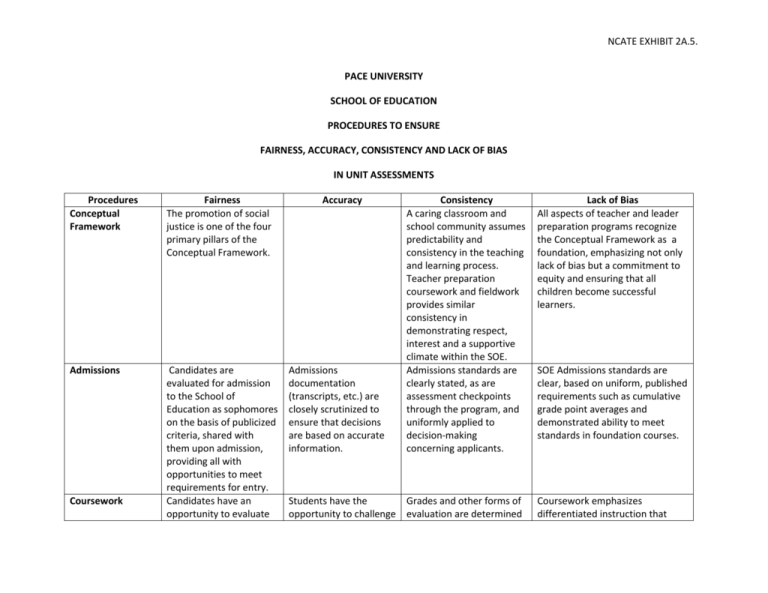
NCATE EXHIBIT 2A.5. PACE UNIVERSITY SCHOOL OF EDUCATION PROCEDURES TO ENSURE FAIRNESS, ACCURACY, CONSISTENCY AND LACK OF BIAS IN UNIT ASSESSMENTS Procedures Conceptual Framework Fairness The promotion of social justice is one of the four primary pillars of the Conceptual Framework. Admissions Candidates are evaluated for admission to the School of Education as sophomores on the basis of publicized criteria, shared with them upon admission, providing all with opportunities to meet requirements for entry. Candidates have an opportunity to evaluate Coursework Accuracy Admissions documentation (transcripts, etc.) are closely scrutinized to ensure that decisions are based on accurate information. Consistency A caring classroom and school community assumes predictability and consistency in the teaching and learning process. Teacher preparation coursework and fieldwork provides similar consistency in demonstrating respect, interest and a supportive climate within the SOE. Admissions standards are clearly stated, as are assessment checkpoints through the program, and uniformly applied to decision-making concerning applicants. Students have the Grades and other forms of opportunity to challenge evaluation are determined Lack of Bias All aspects of teacher and leader preparation programs recognize the Conceptual Framework as a foundation, emphasizing not only lack of bias but a commitment to equity and ensuring that all children become successful learners. SOE Admissions standards are clear, based on uniform, published requirements such as cumulative grade point averages and demonstrated ability to meet standards in foundation courses. Coursework emphasizes differentiated instruction that NCATE EXHIBIT 2A.5. Procedures Fieldwork Fairness their learning experiences at the conclusion of every course. Evaluations are available to individual professors and analyzed as part of a comprehensive system of assessment. Assessment checkpoints ensure that candidates are equipped with the skills, knowledge and dispositions to be successful at the point of entry to fieldwork experiences. Certification New York State certification requirements are published and accessible to all candidates seeking to become teachers or school leaders in the State of New York. Assessment Surveys and other assessments are based Accuracy grades or other forms of evaluation by University policy when they feel their evaluation is inaccurate. Consistency through consistent and clearly articulated expectations and performance standards. Lack of Bias recognizes diversity in the classroom and principles of Universal Design for Learning, adaptations and modifications of content and pedagogy to meet the needs of all learners. Guidelines for clinical supervisors and other faculty who work with candidates in fieldwork settings, as well as personal contact between faculty and mentors in the field ensure that observations and assessments reflect an accurate picture of candidate performance. Close examination and assessment of candidate credentials ensure accuracy on the part of New York State Education Department in approving applications for certification. Every effort is made to ensure that assessments Rubrics and observational guidelines provide a consistent and clearly articulated framework for evaluation candidate performance in fieldwork and internship experiences. Recognition of the needs of diverse learners is modeled by instructors and included in expectations of candidates in fieldwork settings, as well as in classroom experiences. Web-based certification applications ensure that all candidates from Pace or other institutions in the state are evaluated using a consistent framework of requirements. Web-based applications for certification at the State level and “blind” review of candidates’ credentials within the SOE address concerns that the process reflects a lack of bias. Formative and summative assessments are tied to In addition to a grading process that is the same for every student, NCATE EXHIBIT 2A.5. Procedures Fairness on professional standards and reflect fairness in that they make performance expectations clear to students. Rubrics tied to standards allow students to improve performance. Accuracy are accurate, including, in some instances, checks for inter-rater reliability on some assessments. Consistency standards and consistently used to evaluate student performance. Lack of Bias the use of rubrics provides a framework for evaluation that reduces subjectivity and the likelihood of inadvertent bias.

